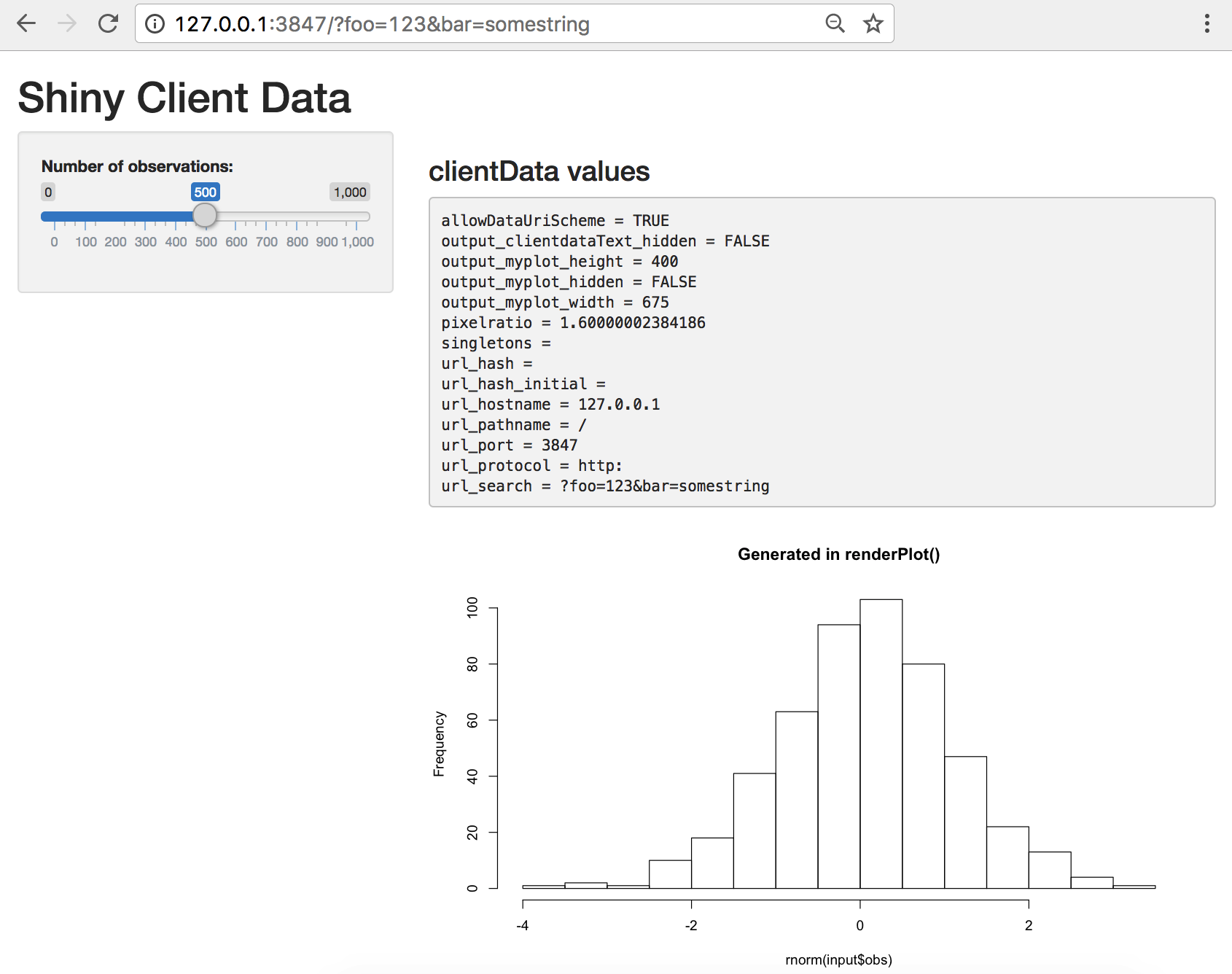Learn about your user with session$clientData
Getting Non-Input Data From the Client
On the server side, Shiny applications use the input object to receive user input from the client web browser. The values in input are set by UI objects on the client web page. There are also non-input values (in the sense that the user doesn’t enter these values through UI components) that are stored in an object called session$clientData. These values include the URL, the pixel ratio (for high-resolution “Retina” displays), the hidden state of output objects, and the height and width of plot outputs. You can see an example app which uses client data here.
Using session$clientData
To access session$clientData values, you need to add a session argument to your server function (session is a special object that is used for finer control over a user’s app session). Once it’s in there, you can access session$clientData just as you would input.
In the example below, the client browser will display out the components of the URL and also parse and print the query/search string (the part of the URL after a “?”):
ui <- bootstrapPage(
h3("URL components"),
verbatimTextOutput("urlText"),
h3("Parsed query string"),
verbatimTextOutput("queryText")
)
server <- function(input, output, session) {
# Return the components of the URL in a string:
output$urlText <- renderText({
paste(sep = "",
"protocol: ", session$clientData$url_protocol, "\n",
"hostname: ", session$clientData$url_hostname, "\n",
"pathname: ", session$clientData$url_pathname, "\n",
"port: ", session$clientData$url_port, "\n",
"search: ", session$clientData$url_search, "\n"
)
})
# Parse the GET query string
output$queryText <- renderText({
query <- parseQueryString(session$clientData$url_search)
# Return a string with key-value pairs
paste(names(query), query, sep = "=", collapse=", ")
})
}
shinyApp(ui, server)This app will display the following (note that the query string, ?foo=123&bar=somestring was added manually to the URL after lauching the app):

Viewing all available values in clientData
The values in session$clientData will depend to some extent on the outputs. For example, a plot output object will report its height, width, and hidden status. The app below has a plot output, and displays all the values in session$clientData:
ui <- pageWithSidebar(
headerPanel("Shiny Client Data"),
sidebarPanel(
sliderInput("obs", "Number of observations:",
min = 0, max = 1000, value = 500)
),
mainPanel(
h3("clientData values"),
verbatimTextOutput("clientdataText"),
plotOutput("myplot")
)
)
server <- function(input, output, session) {
# Store in a convenience variable
cdata <- session$clientData
# Values from cdata returned as text
output$clientdataText <- renderText({
cnames <- names(cdata)
allvalues <- lapply(cnames, function(name) {
paste(name, cdata[[name]], sep = " = ")
})
paste(allvalues, collapse = "\n")
})
# A histogram
output$myplot <- renderPlot({
hist(rnorm(input$obs), main = "Generated in renderPlot()")
})
}
shinyApp(ui, server)Notice that, just as with input, values in session$clientData can be accessed with session$clientData$myvar or session$clientData[['myvar']]. Or, equivalently, since we’ve saved it into a convenience variable cdata, we can use cdata$myvar or cdata[['myvar']].
For the plot output output$myplot, there are at least three entries in clientData:
output_myplot_height: The height of the plot on the web page, in pixels.output_myplot_width: The width of the plot on the web page, in pixels.output_myplot_hidden: If the object is hidden (not visible), this isTRUE. This is used because Shiny will by default suspend the output object when it is hidden. When suspended, the observer will not execute even when its inputs change.
Here is the view from the client, with all the clientData values:

As of Shiny v1.5, this as well as other plot output information (e.g. CSS styles of the HTML container) is accessible via getCurrentOutputInfo(), which provides a more convenient way to access output-specific information since it:
- Returns a list of reactive expressions, allowing reactive expressions that depend on output information to depend on particular output information.
- Uses
htmltools::parseCssColors()to return CSS color string(s) as R color string(s).
To learn more about getCurrentOutputInfo(), see the reference page.